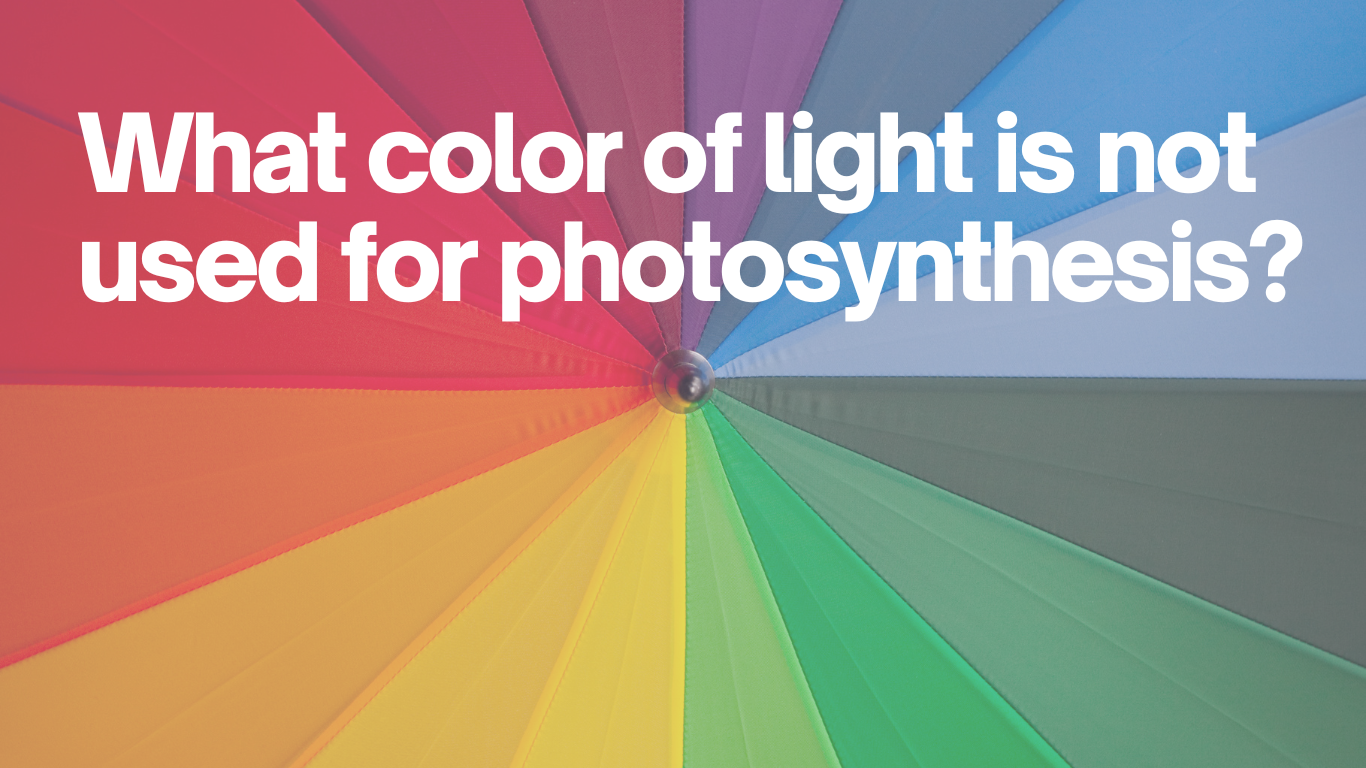What Color of Light is Not Used for Photosynthesis? Before knowing the answer first know what is photosynthesis.
In its most basic form, photosynthesis is the process that produces organic molecules from simple inorganic molecules using the sun’s energy. But there’s a lot more to it than that. Here’s a quick rundown of what photosynthesis is and how it works.
Photosynthesis occurs in two steps: light interference and carbon fixation. In the light interference step, light energy liberates electrons from water molecules. These electrons are then used to produce ATP and NADPH, which are used in the second step to fix carbon dioxide into glucose.
The entire process of photosynthesis takes place in the chloroplasts, organelles found in plant cells that are unique in that they have their DNA and are surrounded by a double membrane. The chloroplasts contain a green pigment called chlorophyll, which is essential for absorbing light energy.
What Color of Light is Not Used for Photosynthesis?
While all colors of light can be used for photosynthesis, there is one color that is not used. That color is “GREEN”. Green light is reflected by plants.
Plants use different colors of light for photosynthesis, but they don’t use green light. Plants reflect green light, which helps them stay cool in sunny environments.
So why don’t plants use green light for photosynthesis? Scientists believe it’s because green light isn’t as effective at driving the chemical reactions that occur during photosynthesis.
The Reason Why the Green Color of Lights is Not Used in Photosynthesis

Chlorophyll, the pigment that gives plants their green color, is key to photosynthesis, the process by which plants convert sunlight into chemical energy. Chlorophyll absorbs all colors of visible light except green, which it reflects. This is why leaves appear green to us.
So why doesn’t chlorophyll use the green light it reflects? Scientists believe it’s because chlorophyll evolved to absorb light at wavelengths that are most effective for photosynthesis. The green light has a shorter wavelength than other colors and thus contains less energy.
So while chlorophyll may not be using the green light it reflects for photosynthesis, it’s still performing an important function in the plant by helping it capture as much sunlight as possible.
The Colors of Light are Used in Photosynthesis
When it comes to light and photosynthesis, two colors of light are used. These colors are blue and red. Blue light is used in the process of photosynthesis to produce energy for plants. Red light is used to help plants grow. Both colors of light are necessary for plants to thrive.
What is the Impact of Color on Photosynthesis?
While most people know that plants need sunlight to grow, few know about the different colors of light and their impact on plant growth. Chlorophyll, the pigment that gives plants their green color, absorbs all colors of light except green. This means that green light is not used for photosynthesis. While one might think that this would hurt plant growth, studies have shown that it has a positive effect. Greenlight encourages more compact growth and helps to prevent etiolation, or stretching, of the plants.
Which Color of the Light Spectrum is Not Used in Photosynthesis?
Photosynthesis is a process that uses all the colors of light that we can see. Ultraviolet light has a shorter wavelength than visible light, so it is not used in photosynthesis. We cannot see wavelengths below 400 nm, so they are called ultraviolet (UV) light. UV light is harmful to our eyes and skin, so we wear sunscreen to protect ourselves from it. However, plants can use UV light for photosynthesis. Plants reflect green light, so they appear green to us. The green light has a wavelength of around 500 nm. The reason why photosynthesis uses all colors of light is that different pigments absorb different colors of light. Chlorophyll, the pigment that gives plants their green color, absorbs red and blue light. This means that green light is not used in photosynthesis.
Why Don’t Plants Use Green Light?
It’s a question that scientists have been asking for years. Greenlight, after all, is abundant in nature. And plants are very good at using other colors of light to photosynthesize and produce the energy they need to grow.
So Why Not Green?
Scientists believe that the answer has to do with the way chloroplasts absorb and use light. Chloroplasts are organelles in plant cells that are responsible for photosynthesis. They have two main types of pigment: chlorophyll a and b.
Chlorophyll a is very good at absorbing blue and red light, while chlorophyll b is very good at absorbing blue and violet light. Greenlight, however, is not absorbed well by either pigment.
What Light is Released During Photosynthesis?
When most people think of photosynthesis, they think of the green light that is a reflection of chlorophyll in plants. However, what light is being released during photosynthesis? All other wavelengths are absorbed and most are utilized as an energy source to create sugar from carbon. The key to understanding this process is to understand what light is being reflected.
For photosynthesis to occur, the chlorophyll must absorb light. Chlorophyll absorbs all wavelengths except green, which it reflects. The absorption of light by chlorophyll creates energy that is used to convert carbon dioxide and water into sugar and oxygen gas. This process is how plants produce their food and release oxygen into the air.
So, when we see plants reflect green light, we are seeing the wavelength that was not absorbed and used for photosynthesis.
The Conclusion
There are many different colors of light, but not all of them are used for photosynthesis. Chlorophyll, the molecule that helps plants absorb light energy, is most effective at absorbing blue and red light. Greenlight is not used as much because chlorophyll reflects it, which is why leaves look green. The yellow and orange light is also not used very much for photosynthesis because they do not have a lot of energy.

